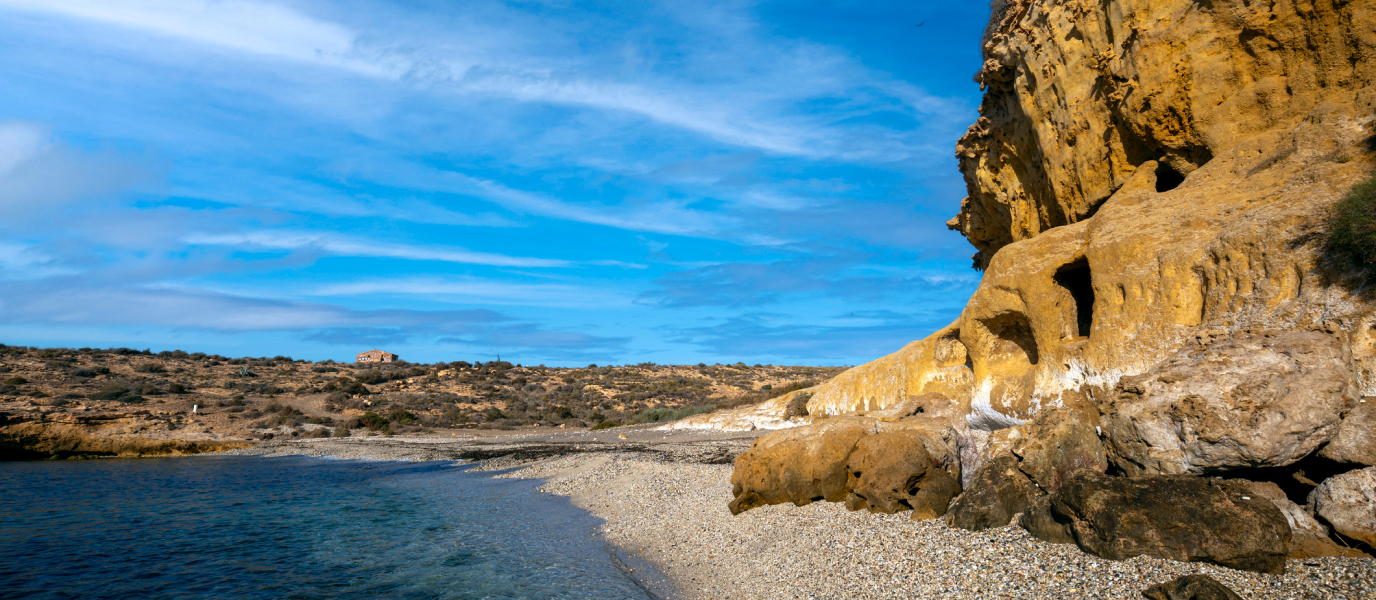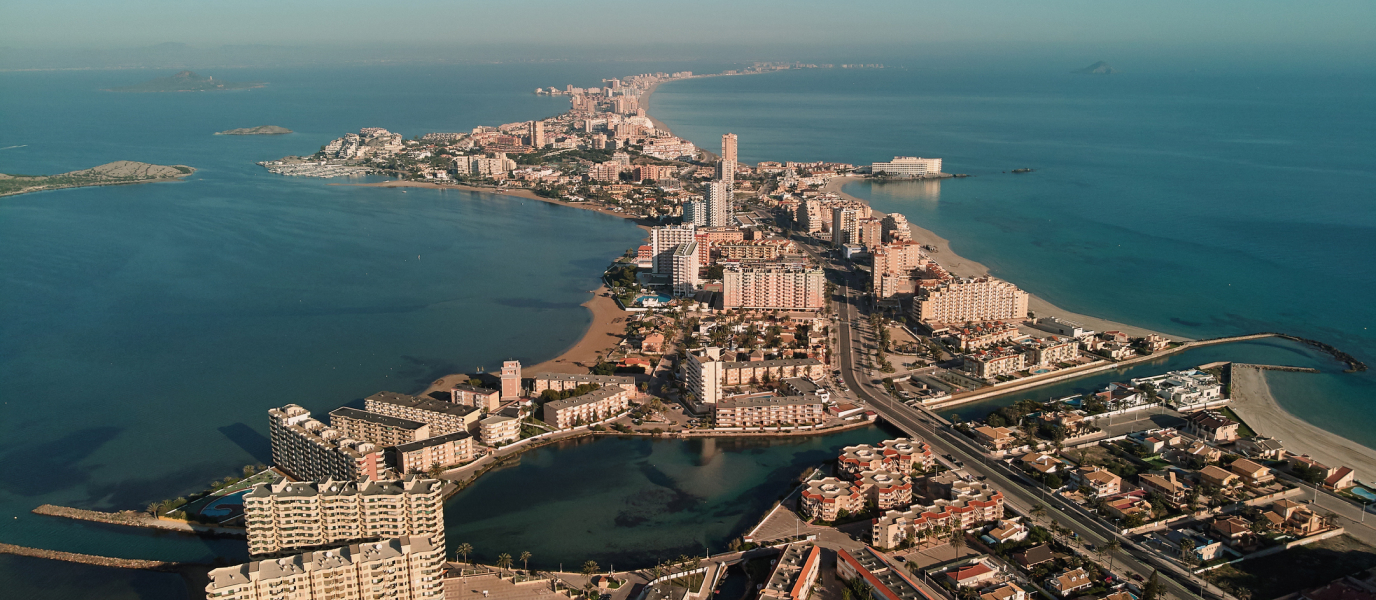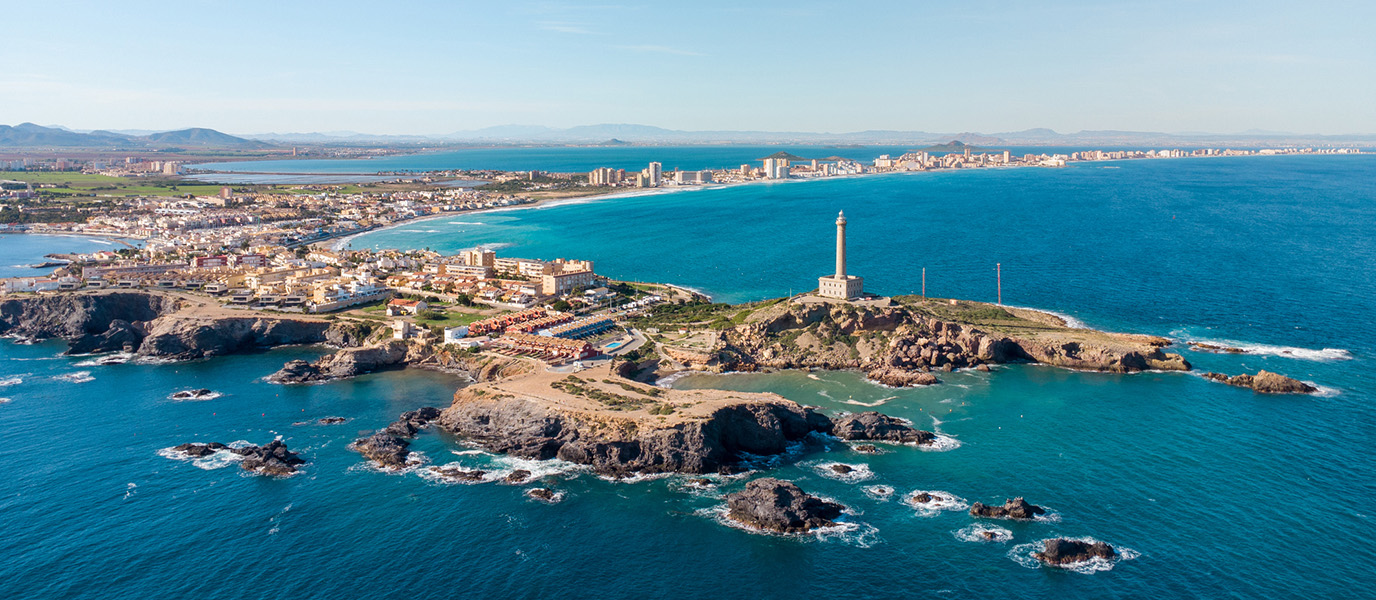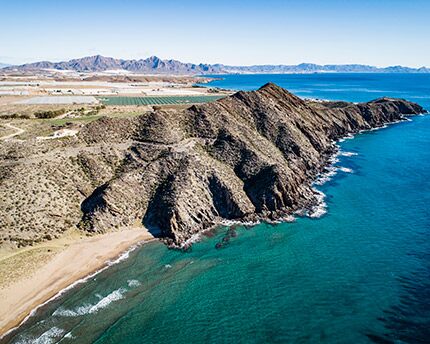The beaches and coves of Puntas de Calnegre are a magical place, one of those little-known corners that contrast magically with their surroundings. If you try to imagine a Murcian beach, you most likely think of a calm sea, a stretch of sand and colourful umbrellas dotted around a beach bar.
The Puntas de Calnegre area has almost none of that, however. Instead, it is an unspoilt area for swimming that is not very crowded, where you must take everything you will need with you.
Natural setting of Puntas de Calnegre
Puntas de Calnegre is located within a protected regional park spanning more than 2,600 square metres between Lorca and Águilas. It is one of the few natural areas in the Mediterranean that has remained unspoilt, with a unique landscape consisting of beach areas, cliffs, salt marshes, dunes and streams… A diverse wild area that makes these 17 kilometres of coastline unique.
Beaches and coves in the area
Calnegre beach
Situated in the Ramonete district, the beach is 190 metres long, making it one of the largest in the area along with Parazuelos beach.
The swimming area has Blue Flag certification and has also been awarded the Eco Beach award for environmental excellence and its service.
Its fine, golden sand is reached by a dirt track and a natural trail, although there is also a parking area.
It is one of the few beaches in the area with services, as well as adapted services, and there is also a lifeguard in July and August.
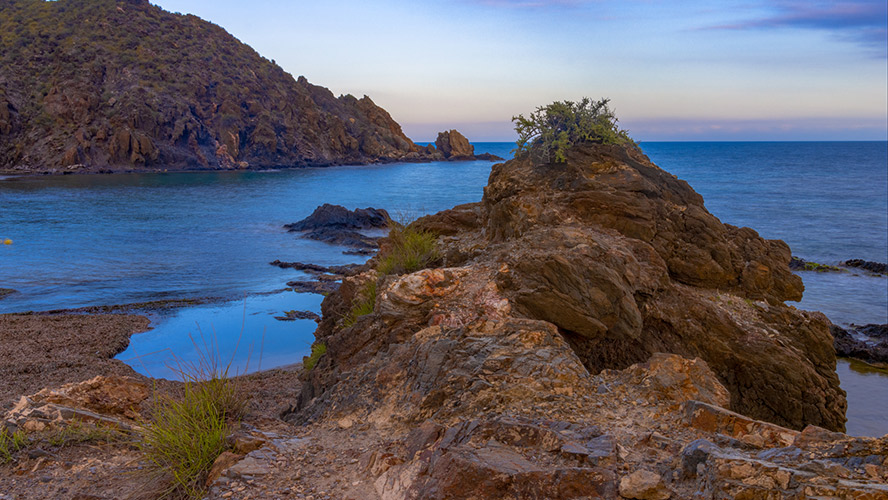
Parazuelos beach
Parazuelos beach is the last beach in Lorca before you come to Mazarrón. It consists of a semi-urban sandy swimming area that offers all the services you may need, including bars and restaurants so you can enjoy the local cuisine. You can reach it by foot from the village of Puntas de Calnegre, where you can leave your car on the waterfront itself.
Baño de las Mujeres
This small stretch of fine sand is also situated in Ramonete. Spanning just 40 metres in length and 30 metres in width, it is very popular among local residents, although bear in mind that it does not have any lifeguards.
You can get to the beachfront via a natural trail and then a dirt track leads to the area. There is also an area reserved for parking.
Puntas de Calnegre beach
This semi-urban beach still has a wild feel to it even though it is in the village of Puntas de Calnegre. The beach consists of both sand and gravel, spanning a length of over one kilometre. Thanks to its location, you can reach it by car, by foot or even by interurban bus, which stops very close by.
The beach has everything a Mediterranean beach has to offer but with a lot fewer beachgoers.

Larga beach
This beach in the middle of a regional park is one of the few that are suitable for bringing pets. But first you have to find it and get there of course. Rather than looking out for signs, the ascents and descents are marked on the trails themselves from the road. The area is surrounded by cliffs but the beach consists of both sand and gravel. It is easy to reach the beach by foot and there is also an area where you can park your car before heading onto the path.
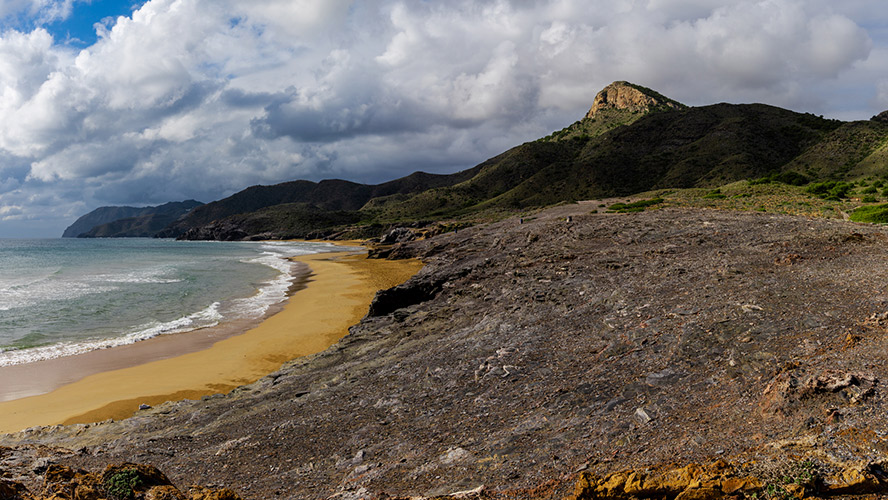
Cala Leña beach
This small cove is not very well known and does not have any services, but it is a great place to take a solitary dip in the Mediterranean in the middle of August. A luxury that is possible in very few places. Getting there is difficult but discovering this place full of native vegetation is well worth the effort. It does have a car park with less than 50 spaces, however.
El Siscal beach
This is a remote but very popular beach among local swimmers with a particular family feel. Located in the Ramonete district, it consists of 200 metres of sand in the middle of an inlet which makes for a nice place to swim. To get to the beach you must take a dirt track from the area reserved for parking. Boats are allowed to enter and exit along a special channel but there are no lifeguards, not even in summer.
Los Hierros beach
This is an almost secret spot that not many people know about. It consists of a small almost remote beach that has a special charm due to the mountainous landscape in which it is set. The beach is both sandy and stony, although the sea is still quite calm. Before you get there you will find a parking area where you can leave your car, although spaces are limited.
San Pedro beach
This swimming spot is almost part of El Siscal beach, as it is located just 100-metres away. In this case, it does not have any parking so you should try to leave your vehicle in the car park of the neighbouring beaches and do not expect anything particularly large or crowded, just 26 metres of fine sand mixed with stones.
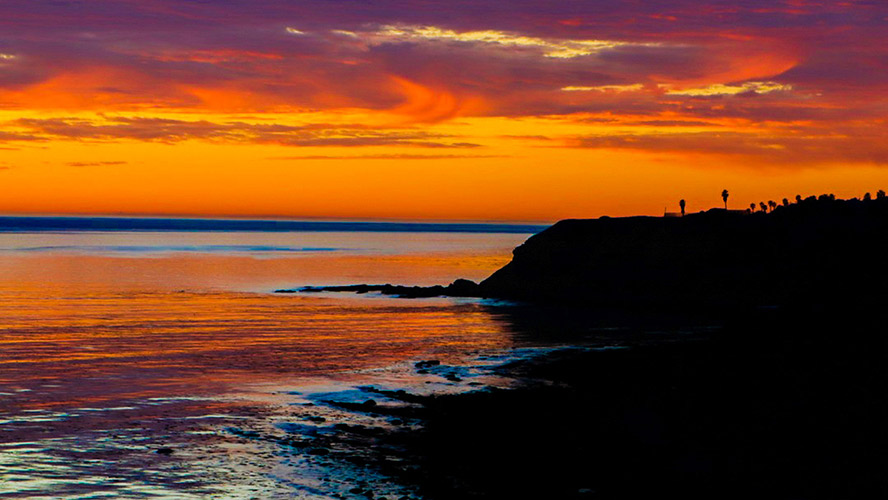
Calahonda
This is a very small cove that is difficult to access given that it is situated in a very rocky, protected area. It does not have any kind of facilities, but if you fancy taking a dip, you will find fine, grey-coloured sand, owing to the mountains that surround it. Getting there is quite complicated, as you need to walk for almost 2 kilometres to get to the swimming spot. It is well worth the effort, however.
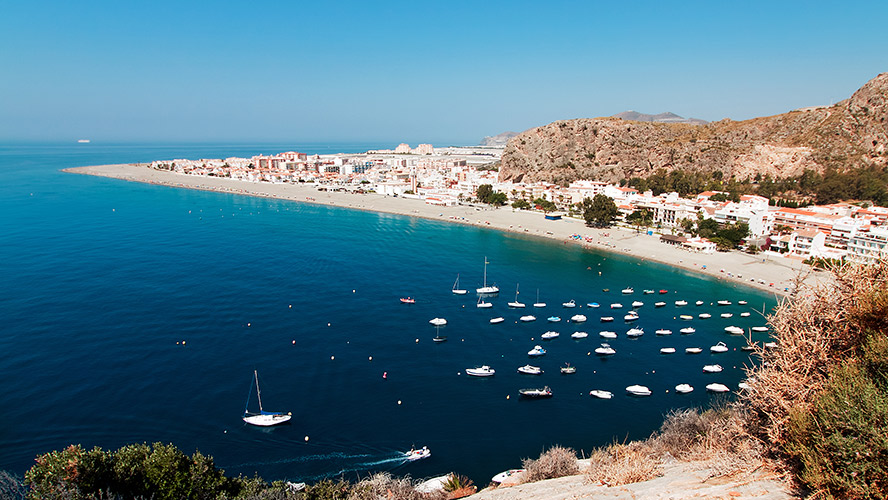
Cala Blanca
This beach does not get very busy, since it is quite remote, although you can get there by car and leave it in the car park before taking the trail towards the sea. In total it spans 75 metres of sand, stones and gravel, surrounded by cliffs, which are perfect for those looking for somewhere peaceful and authentic. The beach boasts native vegetation, giving it an even more natural feel.
Puntas de Calnegre village
It is said that the area is named after some Catalan travellers who, when they arrived in the rocky area, baptised it Black Cove (Calnegre in Catalan), which lead to the current name.
The village has existed since ancient time with close links to fishing. Some crops were also introduced and in the early twentieth century the area flourished even more due to iron and lead mining in Lomo de Bas, very close to Puntas de Calnegre.
In the 1930s the mine closed and local people once again had to return to planting vegetables and fishing until the emergence of tourism.
The village offers a range of different water sports.
Activities to do in the area
You can do a whole host of water sports in Puntas de Calnegre regional park as well as activities on dry land that will help you discover the area’s incredible scenery and coves.
In terms of water sports you can do a spot of kayaking, diving or simply go snorkelling, as the protected waters of these beaches are teeming with fauna and flora.
If you do not want to swim, the whole area is full of marked hiking routes as well as routes for cycling and to explore the cliffs from above.
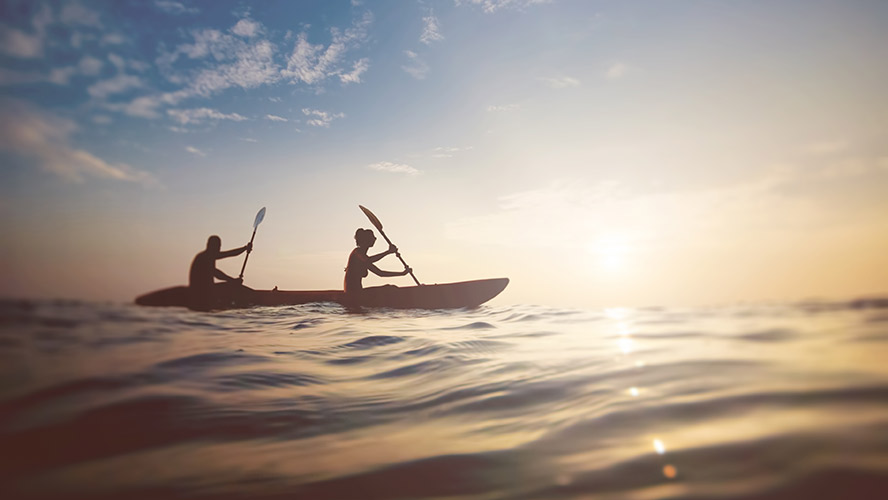
Beach bars and picnic areas
If there is one legendary place in Puntas de Calnegre, it is Bar Mercedes, a popular spot for those who want to try some of their rice dishes or their octopus with potatoes which is famous throughout Murcia.
It is not the only option, however, as you can also find beach bars, such as Parazuelos, which offers hammocks and even cocktails at sunset, or the restaurant Faro de Puntas, which has tables on the sandy beach and spectacular rice dishes.
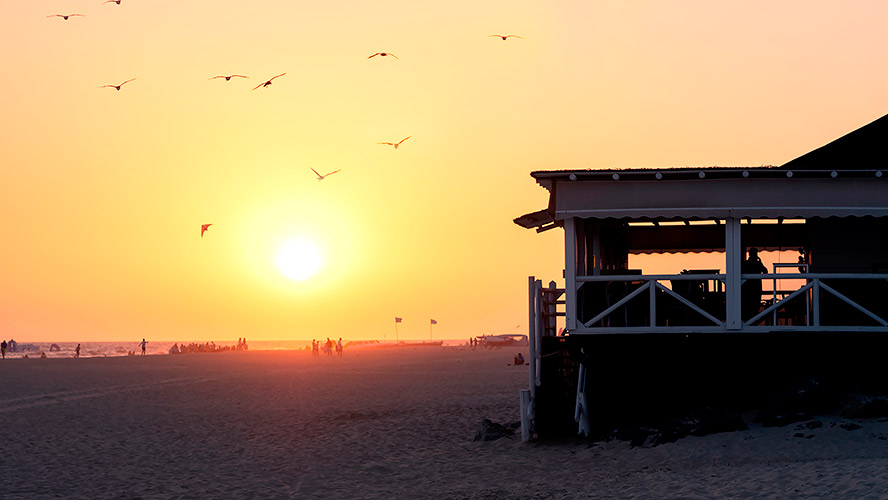
What to see in the surrounding area
If you have a little time to spare, there are many varied options that you can get to from Puntas de Calnegre. One of them is visiting Lorca, which is 48 kilometres away. The city is home to the Fortaleza de la Luz, a medieval castle that was used until the nineteenth century and is well worth a visit. You can also enjoy the Jewish quarter, the old town and some of the traditional festivals, especially in Holy Week, which has been declared a festival of International Interest.
Another fun thing to do is visit Cartagena, which is 57 kilometres away, where you can enjoy the Roman theatre, the museum which houses everything found on the site, and the Naval Museum.
If you do not want to drive too much, Mazarrón is just over 15 kilometres away and is like a theme park for water sports, including whale and dolphin watching at sunset.
And if you would like to carry on enjoying the magical, unspoilt nature, just 20 kilometres away is Gredas de Bolnuevo, a rocky area carved out by the wind and water that is completely unique.
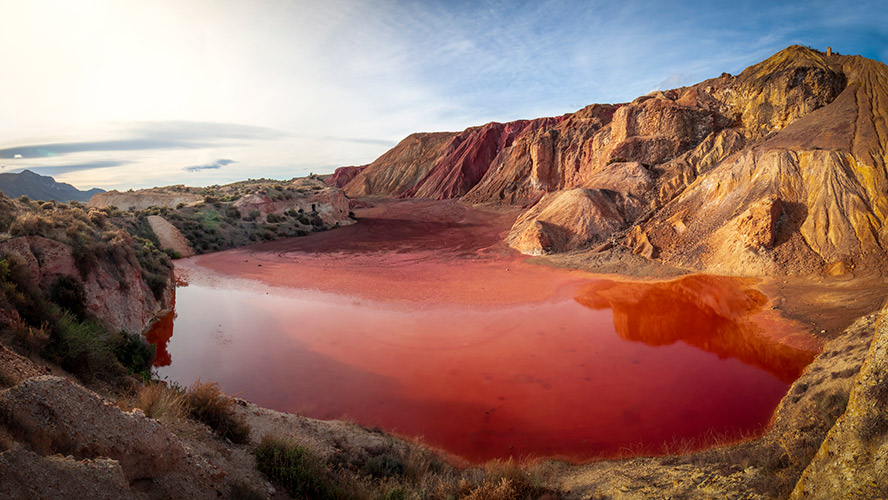
Where to stay in the province of Murcia
If you decide to stay in the city of Murcia, one of the best options is the Occidental Murcia Siete Coronas, a four-star hotel situated in the city centre whose facilities have been refurbished, converting it into the most modern hotel in Murcia.
From the hotel you can reach the Segura river, the old town and the cathedral by foot. It is also very well connected by public transport in case you would like to visit other parts of Murcia.
Its 156 rooms, many of them with views of the city, offer a bright, modern stay and the most efficient service. The hotel also has a gym, an incredible restaurant with a terrace and nine multifunction rooms equipped with the latest technology. There is also an area reserved for parking your car and you can stay with your pet, which means you can travel with the whole family.
The hotel is a great example of what the city is about, the best culture and modernity without leaving aside the tradition and crafts learnt along the way.




































































